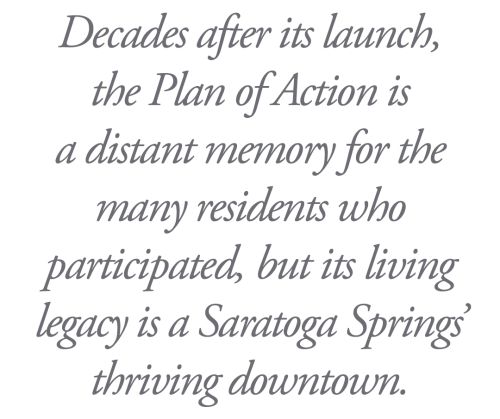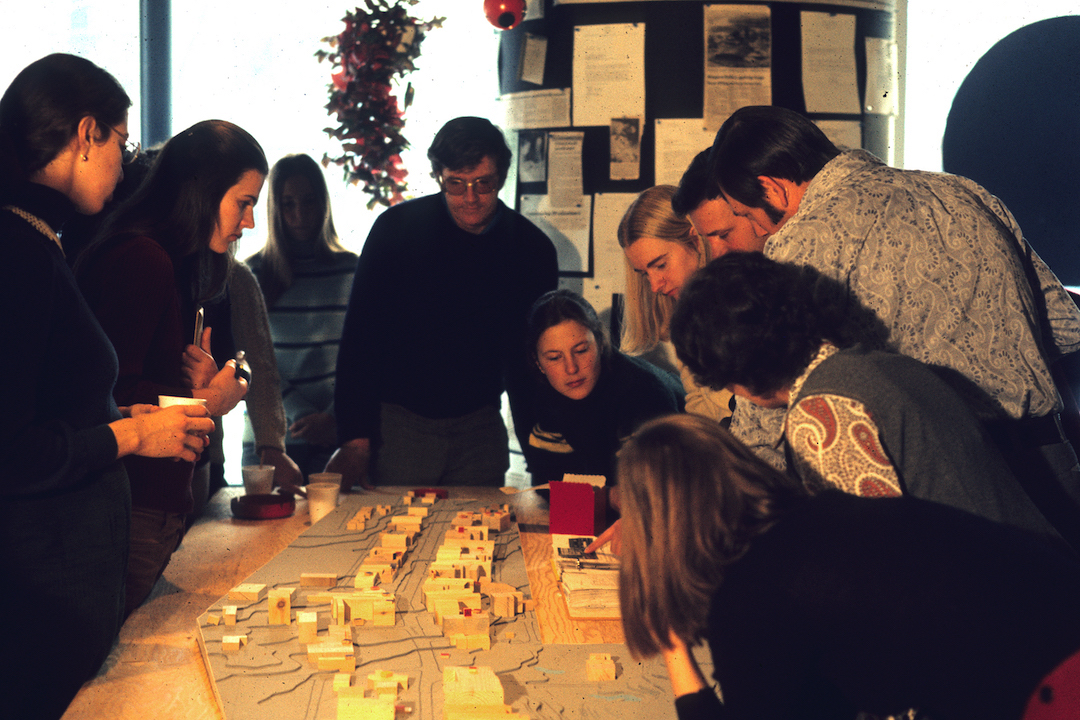Articles
The Plan of Action
Photos courtesy of the Saratoga Associates.

Saratoga Springs’ vibrant downtown business district is the envy of most other upstate New York cities. But without the Plan of Action, conceived by the Chamber of Commerce and commenced in 1973-74, the city very likely would not have achieved such success.
By 1973, the community could take pride in a number of successes including SPAC and the shareholder-owned Holiday Inn, but its downtown problems had not yet been solved. Shopping centers first arrived in the city in 1954 when the site of the Grand Union Hotel on Broadway was turned into a strip center to house, in a bit of irony, a Grand Union supermarket. It was followed in 1966 by a “suburban” center, West Hill Plaza at West Avenue and Washington Street. Downtown retail began to decline.
By 1973, 22 downtown storefronts were vacant, with almost-empty second and third floors above them. And, ominously, a developer had begun construction of the Pyramid Mall just east of Northway Exit 15. It was bringing what Sal DeVivo, then board president of the Chamber of Commerce, called a “death squeeze on the downtown area by new shopping centers.”
While the Chamber had always worked to strengthen retail trade, its leadership made a strategic decision to shift its efforts from the usual promotion work to revitalization, a far more challenging task. This required that it work chiefly with the property owners rather than the retailers. Just as the new mall was about to open, Joe Dalton of the Chamber and Bob Bristol of The Saratoga Associates, a local planning firm, called a meeting with a dozen property owners. They met in the boardroom of the Adirondack Trust Company and listened as Bristol and Dalton proposed a “Plan of Action” that would galvanize the community into revitalizing its downtown. Their vision was to create immediate visibility, and to generate the level of sustained excitement that would transform Broadway.

Their idea was so well received, that the attendees at that initial meeting agreed to launch the plan. The Saratoga Associates agreed to be the technical advisor and the Chamber offered its organizational expertise. Within a few weeks, 78 citizens volunteered to work on the effort. Just as the Pyramid Mall went about the “creation of a fun world” for shoppers, the Plan of Action went into operation. Bill Dake of Stewart’s guided it for six months, after which Charles Wait of the Adirondack Trust Company served as its chairman. The plan was to have three stages: immediate, including education and planning but, significantly, smallscale clean-up projects for visibility; short-term, including the development of the overall plan, an unofficial review process for building restoration, and further visibility efforts; and long-term, the creation of a master plan.
Professional planners began an analysis of existing conditions, while the committee volunteers conducted an intensive survey of 20 percent of voters, senior citizens, Skidmore students and 90 percent of downtown business owners. The committee also held more than 60 public meetings to educate the general public and challenge citizens to get involved.
On January 6, 1974, the Plan of Action committee opened a storefront office on Broadway in donated space, and began an innovative exercise that drew an interested and excited audience. Using a 6-by-18 foot scale model of downtown created by the Skidmore College Art Department, the committee invited community residents to play a spatial game in which they could design their ideal downtown. In just 26 days, more than 1,000 people visited the Plan of Action office.
Unlike all other previous revitalization efforts over the previous century, this was to be a plan “of action.” So in addition to the educational and planning components of the first phase, clean-up projects were undertaken to show that something tangible was being accomplished. Grassroots action made a powerful impact: that fall an all-volunteer crew dug holes and planted 80 mature trees in the business district, the number reaching 250 within two years. Volunteer planners and designers advised property owners on restoration efforts.

Funding for these early initiatives came from property owners, who agreed to invest $12,000 for the basic design plan. In dealing with government the Plan found their first elected ally in Department of Public Works commissioner Tom McTygue, but it realized public funds would not be forthcoming until the private sector showed its financial support. In response, the Plan of Action leadership proposed the creation of a special assessment district to raise funds, an idea that was endorsed by 73 percent of the property owners affected. Two other primary revenue sources were needed to support the revitalization of downtown Saratoga Springs: a 1 percent city sales tax increase, enacted by the City Council, and federal Community Development funds.
With these revenues coming in, the plan’s steering committee was able to tackle the five projects it had identified as critical: facade improvement, parking improvement, streetscape, maintenance and promotion.
The Plan of Action was a grassroots effort using an experimental method, but it worked. In its first year, $2.5 million had been committed or spent, 100 percent of it local money and only half from public sources such as the sales tax increase.
Within a decade, the success was striking. Seventy percent of downtown businesses were new, and the community’s future in specialty shops and restaurants was becoming evident. A vacancy became a rarity, and Saratoga Springs was known throughout the region for its excellent specialty shopping and its lively street life.
Saratoga Springs’ downtown faced powerful competition in the 80’s and 90’s from an extraordinary expansion of the Route 50 retail corridor in Wilton, but Saratogians responded. They built new parking facilities, a state of the art convention center, dozens of aesthetic improvements and new upscale commercial and residential buildings. Decades after its launch, the Plan of Action is a distant memory for the many residents who participated, but its living legacy is Saratoga Springs’ thriving downtown.
